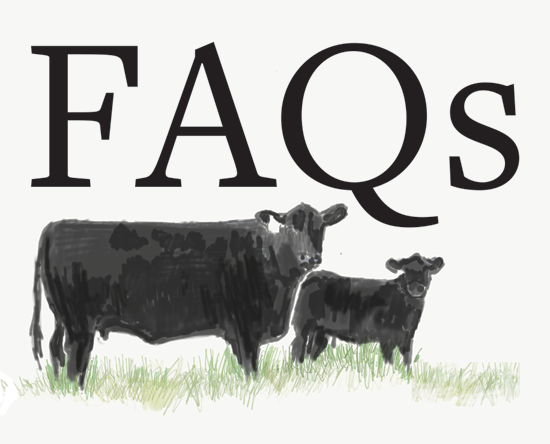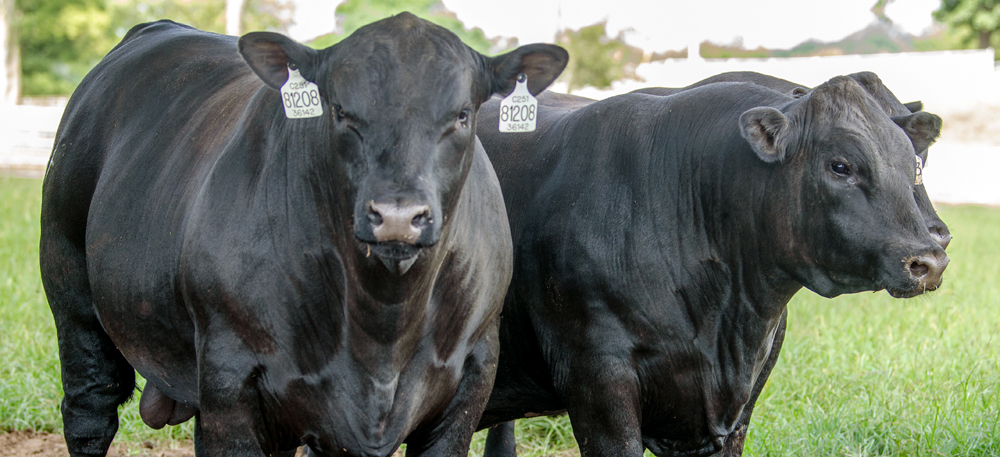
When comparing breed-of-sire averages using across-breed adjustment factors, Angus continues to have some of the lightest birth weights, heaviest yearling and carcass weights, and best marbling score. Photo by Shauna Hermel
The Advantage Within
USMARC data confirm the breed offers the best combination of growth, calving ease and carcass value in addition to it being naturally polled with great maternal value.
The naturally polled head, dark skin around the eyes and superb mothering abilities helped Angus gain early popularity. The dominance of the black coat color made Angus easily recognizable, but what makes the breed most special could be what is under the hide.
Genetic change and progress have been rapid in the Angus breed due to the commitment of seedstock breeders to data collection. From birth and weaning weights to carcass ultrasound collection, and now fertility and temperament recording, Angus breeders are working to describe their genetics to the best of their ability.

Kelli Retallick-Riley |
Coupled with advanced expertise in data analysis, the American Angus Association has worked to present the best genetic description of Angus cattle anywhere in the world.
The Angus database is a leader in its kind. Annually, the Association registers more than 300,000 head in its Herd Book, records more than 400,000 birth weights, and submits more than 180,000 genomic tests. In total, it contains millions upon millions of individual weight records, as well as hundreds of thousands of observations for foot conformation, fertility and environmental adaptability (i.e., hair shedding).
With that, it utilizes the world’s largest genomic (DNA) database, with more than 1.1 million genotypes being used weekly to describe Angus genetics.
What’s in it for you?
What does that mean to the commercial cattleman? Well, it gives you peace of mind when you are buying a registered Angus bull that his genetic descriptions are the best, most robust, and most accurate picture of genetic merit in the industry. These genetic descriptions, known as expected progeny differences (EPDs), are updated weekly at the American Angus Association to ensure the most current and recent information is utilized.
However, did you know that not all EPDs are created equal?
In fact, EPDs from different breeds — like Charolais, Hereford, Brahman and Angus — cannot be directly compared against one another. While EPDs have been responsible for substantial genetic progress over the years, EPDs are generally only comparable within each breed. That’s because different breed information, such as the performance weights and measures I described, are generally kept in separate herd books of origin. With that, each breed links its genetic evaluation back to a different base population, making it nearly impossible to effectively compare EPDs on different breeds at the surface.
Means of comparison
For this reason, since 1993, the U.S. Meat Animal Research Center (USMARC) has provided a table of adjustment factors. These third-party adjustment factors are derived from the USMARC Germplasm Evaluation Project, in which the group uses a herd of commercial cows bred to several prominent sires of each of the most popular breeds used in the U.S. beef industry. From there, the group determines breed differences among the progeny that have been given the same management and resources to perform.
They then adjust the differences expressed in these progeny by the differences of the sire EPDs that were sampled in the project. The across-breed adjustment factors use simple math to adjust, for example, a Hereford bull to an Angus base.
The adjustment factors in Table 1 can be added to the respective within-breed EPD to adjust it to an Angus base.
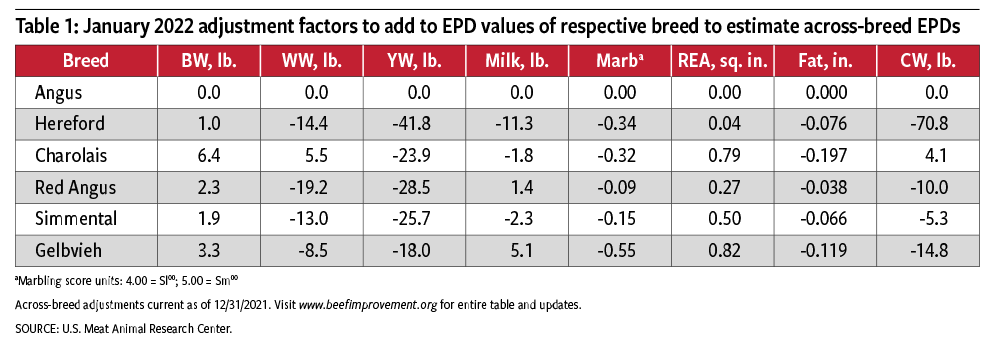
After across-breed adjustments are applied, a commercial producer can directly compare the resulting across-breed EPDs (AB-EPDs) amongst the different breeds. This allows for fair comparison, whereas, before producers could be misled by base adjustments in a different population.
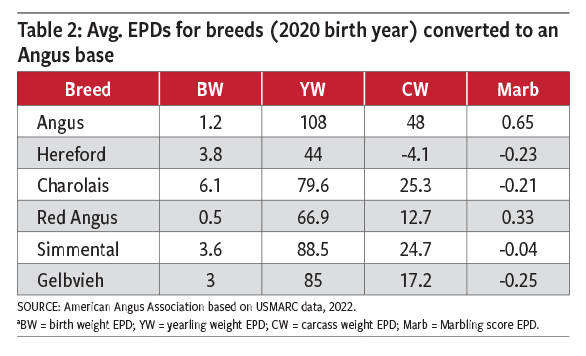 |
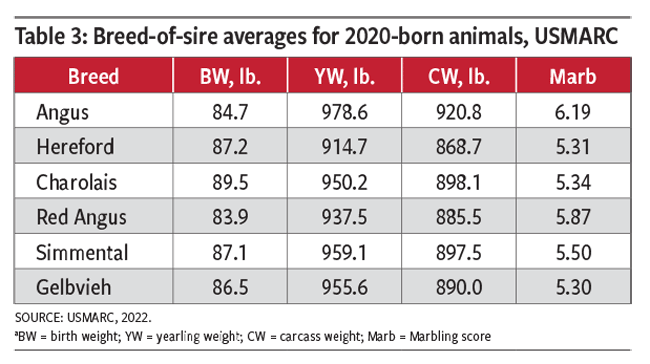 |
Table 2 describes the average EPDs for each breed (2020 birth year) converted to an Angus base using the 2022 USMARC across-breed adjustment factors.
The project also benchmarks breed mean sire differences, which explains the average breed-of-sire differences when bulls from two different breeds are mated to cows of a third, unrelated breed.
It is noteworthy to mention that these differences could be greater or smaller in comparison when conditions vary greatly from those commercial cow-calf conditions experienced at USMARC in Nebraska.
When comparing those breed-of-sire averages, Angus continues to have some of the lightest birth weights, heaviest yearling and carcass weights, and best marbling scores compared to other breeds in the beef industry.
Table 3 shows the breed-of-sire means for 2020-born animals under conditions similar to those at USMARC for birth weight, yearling weight, carcass weight and marbling score.
As one can see, the Angus advantage continues. Not only is the breed still naturally polled with great maternal abilities, it also offers the best combination of growth, calving ease and carcass value. Visit https://www.angus.org/Nce/AcrossBreedEpdAdjFactors to see a full list of the across-breed adjustment factors published by USMARC.
Editor’s note: A regular column in the Angus Beef Bulletin authored by AGI staff, “Sorting Gate” features herd improvement topics for commercial producers using Angus genetics. For additional information on performance programs, visit www.angus.org and select topics under the “Management” tab. To read read past issues or subscribe to the Angus Beef Bulletin, access the ABB pull-down menu at the top of this page.
